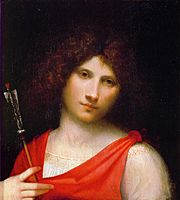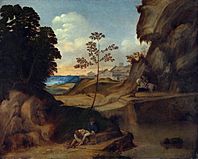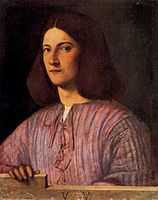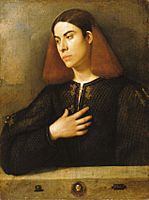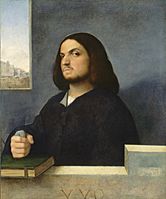Giorgione facts for kids
Quick facts for kids
Giorgione
|
|
|---|---|
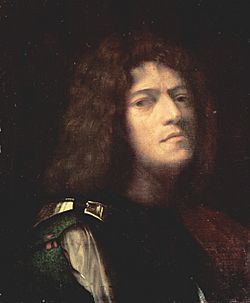
A possible self-portrait, perhaps as David
|
|
| Born |
Giorgio Barbarelli da Castelfranco
1477–78 or 1473–74 Castelfranco Veneto, Republic of Venice (present day Veneto, Italy)
|
| Died | 1510 (aged 31–37) Venice, Republic of Venice (present day Veneto, Italy)
|
| Nationality | Republic of Venice |
| Education | Giovanni Bellini |
| Known for | Painting |
|
Notable work
|
The Tempest Sleeping Venus Castelfranco Madonna The Three Philosophers |
| Movement | High Renaissance (Venetian school) |
Giorgione (born Giorgio Barbarelli da Castelfranco; 1477–78 or 1473–74 – 17 September 1510) was an important Italian painter. He belonged to the Venetian school during the High Renaissance period. He died quite young, in his thirties.
Giorgione is famous for the mysterious and poetic feeling in his artworks. However, only about six of his paintings are definitely known to be by him. This mystery about his art and its meaning makes Giorgione one of the most puzzling artists in European history.
He, along with a slightly younger artist named Titian, helped create the Venetian style of Italian Renaissance painting. This style was known for its beautiful use of color and its ability to create a certain mood. It was different from the Florentine style, which focused more on clear lines and drawing.
Contents
Giorgione's Early Life and Career
Most of what we know about Giorgione comes from a book by Giorgio Vasari called Lives of the Most Excellent Painters, Sculptors, and Architects. Giorgione came from a small town called Castelfranco Veneto, which is about 40 kilometers (25 miles) from Venice. His name Giorgione means "Big George."
It's not clear when he moved to Venice as a boy. But his painting style suggests he learned from Giovanni Bellini there. He settled in Venice and became a well-known master painter.
Early Recognition and Important Commissions
Documents from his time show that people recognized his talent early on. In 1500, when he was in his twenties, he was chosen to paint portraits of important people. These included the Doge (the leader of Venice) and a military commander.
In 1504, he was asked to paint a special altarpiece for his hometown cathedral. This painting was in memory of another military leader. From 1507 to 1508, he worked with other artists to paint frescoes (wall paintings) on the outside of buildings in Venice. Very little of these outdoor paintings still exist today.
Giorgione's Artistic Style and Influence
Vasari wrote that Giorgione met Leonardo da Vinci when Leonardo visited Venice in 1500. Everyone described Giorgione as a charming and romantic person. He loved music and showed the graceful, dreamy mood of Venetian life in his art.
He was very close to Titian, another famous painter. Some say Giorgione was Titian's teacher, while others say they both learned from Giovanni Bellini. They even worked together on some fresco projects. Titian also finished some of Giorgione's paintings after he died.
Giorgione also brought new ideas to painting. Besides religious altarpieces and portraits, he painted pictures that didn't tell a specific story from the Bible or history. Instead, they showed feelings or moods using colors and shapes, much like music does. He had a huge impact on other artists in Venice, including Titian and his own teacher, Giovanni Bellini.
Giorgione's Death and Lasting Mystery
Giorgione died from the plague on September 17, 1510. The plague was a serious disease that spread widely at that time. He was likely buried on an island used for quarantine (keeping sick people separate).
Even after his death, people were fascinated by his name and work. But it's very hard to know exactly which paintings are truly his. Many paintings from that time look similar to his style. Some experts believe only a few of his paintings still exist today.
Famous Works by Giorgione
The Castelfranco Madonna
For his hometown, Giorgione painted the Castelfranco Madonna. This was an altarpiece showing the Madonna (Mary) on a throne with saints on each side. The landscape in the background was very important in this painting. This was a new idea in Venetian art, and his teacher Giovanni Bellini quickly followed it.
Giorgione also started using a painting technique called sfumato. This is a delicate way of using shades of color to show light and depth. He used it around the same time as Leonardo da Vinci. This technique gave Giorgione's paintings a magical, glowing light.
Sleeping Venus and Other Figure Paintings
One of Giorgione's most important works is the Sleeping Venus in Dresden. This painting shows a beautiful, pure figure of a goddess. The white cloth she lies on and the glowing landscape behind her perfectly frame her.
It is believed that Giorgione left this painting unfinished. Titian, his fellow artist, completed the landscape and a small Cupid figure (which was later removed). This painting became a model for many other artists, including Titian's famous Venus of Urbino.
Another painting showing idealized beauty is Judith from the Hermitage Museum. This large painting shows Giorgione's rich colors and romantic landscapes. It also suggests that life and death are connected.
Most of Giorgione's surviving works, apart from the altarpiece and frescoes, are small paintings. They were made for wealthy Venetian collectors to keep in their homes. Giorgione was one of the first major Italian painters to focus so much on these smaller, private artworks.
The Tempest and Enigmatic Landscapes
The Tempest is often called the first true landscape painting in Western art. The meaning of this painting is still a mystery. It shows a man and a woman near a stream, with city ruins and a storm approaching. Many ideas have been suggested for its meaning, but none fully explain it.
The Three Philosophers is another mysterious painting. It's not even certain if Giorgione painted all of it. The three figures stand near a dark cave. They seem lost in a dreamy mood, which is typical of Giorgione's landscapes. A hazy light adds to this feeling.
The Pastoral Concert, now in the Louvre, also shows the Venetian love for different textures. The painter makes the skin, fabric, wood, stone, and leaves feel almost real. This painting has no harsh lines, and its landscape is often compared to poetic scenes.
Revolutionary Portraits
Giorgione and the young Titian also changed how portraits were painted. It's very hard to tell the difference between Giorgione's early works and Titian's. None of Giorgione's paintings are signed. Only one has a reliable date: his portrait of Laura (1506). This was one of the first portraits painted in a "modern way," showing dignity and clear character.
The Portrait of a Young Man in Berlin is also highly praised. Art experts admire its calm expression and sculpted look. Many of Giorgione's portraits were not just simple records of a person's appearance. They were often meant to show a certain mood or feeling.
How Experts Identify Giorgione's Paintings
It's very hard to know for sure which paintings were done by Giorgione. This is because some of his paintings were finished by other artists after he died. Also, his great fame led to many paintings being wrongly attributed to him. Most records from this time are for large church or government artworks. Smaller paintings for homes were less likely to be recorded. Other artists also continued to paint in his style for many years.
Key Documents and Accepted Works
A Venetian collector named Marcantonio Michiel wrote notes between 1525 and 1543. He listed twelve paintings and one drawing as being by Giorgione. Art historians generally agree on five of these paintings: The Tempest, The Three Philosophers, Sleeping Venus, Boy with an Arrow, and Shepherd with a Flute.
Michiel said that Sebastiano del Piombo finished The Three Philosophers. He also said Titian finished Sleeping Venus (it's now agreed Titian did the landscape). So, The Tempest is the only one from this group that is fully accepted as being entirely by Giorgione.
The Castelfranco Altarpiece in his hometown is also rarely doubted. The Laura portrait in Vienna is the only work with his name and the date 1506 on the back. This date seems to be from his time.
Challenges in Attribution
Things get more complicated when trying to tell Giorgione's work from the young Titian's. For example, the Pastoral Concert in the Louvre is one of the most debated paintings in Italian Renaissance art. Some experts now think it might be by Titian, or even a less known artist named Domenico Mancini.
It's also hard because no drawing can be definitely identified as Giorgione's. This makes it harder to understand his painting style.
Many paintings once thought to be by Giorgione, especially portraits, are now known not to be his. But the debate continues strongly today. Experts are still trying to figure out which paintings truly belong to this mysterious master.
Giorgione's Lasting Impact
Even though he died young, Giorgione left a huge mark on art. His ideas were further developed by Titian and other artists in the 17th century. Giorgione never let lines or colors be less important than the overall design. He was likely the first Italian artist to paint landscapes with figures just for the beauty of the picture itself. These paintings didn't always have a religious or historical meaning.
He was also the first whose colors had that warm, glowing, and soft intensity. This style soon became a key feature of all the artists in the Venetian School.
Selected Works
- The Test of Fire of Moses (1500–1501) - Uffizi, Florence
- The Judgement of Solomon (1500–1501) - Uffizi, Florence
- Judith (c. 1504) - Hermitage Museum, St. Petersburg
- Adoration of the Shepherds (c. 1505–10) - National Gallery of Art, Washington
- Castelfranco Madonna (c. 1505) - Duomo, Castelfranco Veneto
- Portrait of a Young Bride (Laura) (c. 1506) - Kunsthistorisches Museum, Vienna
- The Tempest (c. 1508) - Accademia, Venice
- La Vecchia (Old Woman) (c. 1508) - Accademia, Venice
- Pastoral Concert (c. 1509) - Louvre, Paris
- Portrait of a Youth (1508–10) - Museum of Fine Arts, Budapest
- The Three Philosophers (1509) - Kunsthistorisches Museum, Vienna
- Portrait of Warrior with his Equerry (c. 1509) - Galleria degli Uffizi, Florence
- Sleeping Venus (c. 1510) - Gemäldegalerie, Dresden
- The Impassioned Singer (c. 1510) - Galleria Borghese, Rome
- Portrait of a Young Man - Alte Pinakothek, Munich
Gallery
-
Young Man with Arrow, (1506?) Kunsthistorisches Museum, Vienna
-
Portrait of a Venetian Gentleman, by Giorgione and Titian 1510 – National Gallery of Art
See also
 In Spanish: Giorgione para niños
In Spanish: Giorgione para niños



